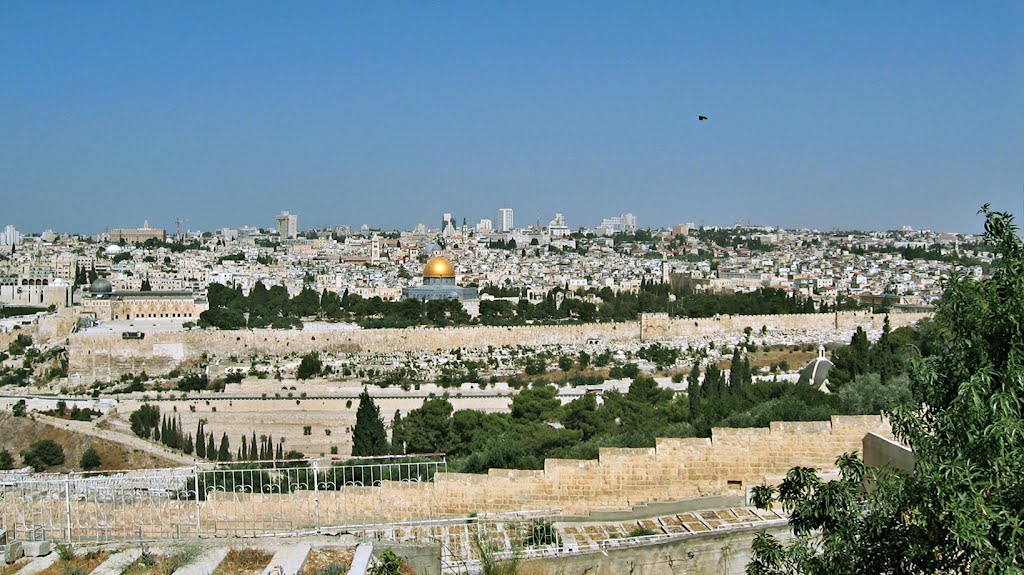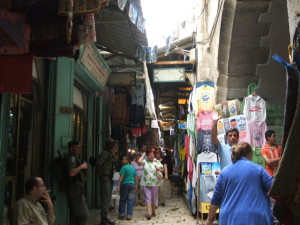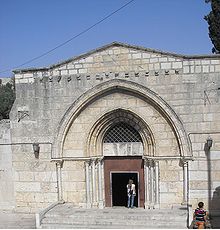King David’s Tomb, The Mount of Olives, Church of the Lord’s Cry (over Jerusalem), and Tomb of the Virgin Mary

In addition to our visit to the Garden Tomb on our first day in Jerusalem, we also visited the site of King David’s Tomb. This place is popular not only with foreign tourists but it is also popular with local Jewish faithful who pray at this site believing that King David may still be able to influence the Israelis who are descended from the time of his earthly reign.
The City of David sounds like a unique and separate place from Jerusalem but in reality it is only about 300 yards outside the wall of the Old City and about one mile from the Garden of Gethsemane.
We were ready for lunch and so our bus took us a short distance back into the Old City where we disembarked for a walking tour through a merchant/eating area of semi outdoor shops called the Cardo (or heart of the City). Our guide, Moshe explained how the Cardo was an ancient part of the daily life of Jerusalem and showed us a large wall map depicting the Old City and the central location of the Cardo.
After lunch we were bused across the Kidron Valley to the Mount of Olives where we had commanding views of the City, The Wall and the Garden of Gethsemane across the valley from us. While we tried to absorb the actual site where Jesus made his triumphal entry into Jerusalem at the time of Palm Sunday, we were directed toward two memorial buildings on our side of the valley and part of the way up the hillside of the Mount of Olives.
The first that looked like a large tear drop is
Dominus Flevit Church
| Dominus Flevit Church | |
|---|---|

View from the Courtyard
|
|
| Basic information | |
| Location | Jerusalem |
| Affiliation | Roman Catholic |
| Leadership | Franciscan Order |
| Architectural description | |
| Architect(s) | Antonio Barluzzi |
| Completed | 1955 |
Dominus Flevit is a Roman Catholic church on the Mount of Olives, opposite the walls of the Old City of Jerusalem. The church was designed and constructed between 1953 and 1955 by the Italian architect Antonio Barluzzi and is held in trust by the Franciscan Custody of the Holy Land. During construction of the sanctuary, archaeologists uncovered artifacts dating back to the Canaanite period, as well as tombs from the Second Temple and Byzantine eras.
History
Dominus Flevit, which translates from Latin as “The Lord Wept”, was fashioned in the shape of a teardrop to symbolize the tears of Christ. Here, according to the 19th chapter of the Gospel of Luke, Jesus, while walking toward the city of Jerusalem, becomes overwhelmed by the beauty of the Second Temple and predicting its future destruction, and the diaspora of the Jewish people, weeps openly (an event known as Flevit super illam in Latin language).
You can find out more details about the Dominus Flevit Church including several high quality images at:
http://en.wikipedia.org/wiki/Dominus_Flevit_Church
Tomb of the Virgin Mary
Church of the Sepulchre of Saint Mary, also Tomb of the Virgin Mary, is a Christian tomb in the Kidron Valley – at the foot of Mount of Olives, in Jerusalem – believed by Eastern Christians to be the burial place of Mary, the mother of Jesus .[1]
History
The Sacred Tradition of Eastern Christianity teaches that the Virgin Mary died a natural death (the Dormition of the Theotokos, the falling asleep), like any human being; that her soul was received by Christ upon death; and that her body was resurrected on the third day after her repose, at which time she was taken up, soul and body, into heaven in anticipation of the general resurrection. Her tomb, according to this teaching, was found empty on the third day. Roman Catholic teaching holds that Mary was “assumed” into heaven in bodily form, the Assumption; the question of whether or not Mary actually underwent physical death remains open in the Catholic view; however, most theologians believe that she did undergo death before her Assumption.
You can find out more about the Tomb of the Virgin Mary and see several high quality images, including the tomb itself at:
http://en.wikipedia.org/wiki/Tomb_of_the_Virgin_Mary
We concluded our touring activities of this the first day of our time in Israel quite overwhelmed by all we had already seen as the pages of the Bible were coming to life right before our eyes. For a Christian, this is a life-changing experience and we had only scratched the surface.
We were tired but anxious to see more tomorrow.
Earlier posts include:
Our Spiritual Trip of a Lifetime to the Holy Land
Where was Jesus Crucified, Buried and Resurrected?


